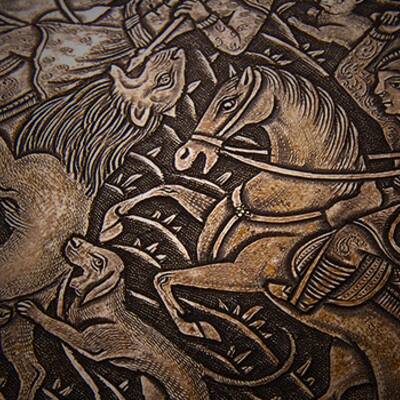.jpg)
Zanjan Filigree
Filigree is one the most important applied arts of province of Zanjan. Filigree is a kind of metalwork, and researchers have traced it back to 550 to 330 B.C. Many filigree artifacts have been discovered in Susa, Dura-Europos, Hamedan and Jeyhoun treasure which prove that this craft was practiced from ancient times. Very few historic records exist about filigree of Zanjan, however explorers who have visited there have mentioned beautiful filigree handicrafts and jewels. Based on these records, 16th century is the first recorded history for filigree. Today most filigree products are of sliver, which is obtained by melting silver objects that are old and obsolete. Some of other components that are used include natural wax, aqua regia, alum and sulfuric acid. The tools used in filigree making are very similar to those of goldsmithing. The first step of filigree making is to pass stocks of silver, gold or copper through rolling machine to turn them into thin threads with thickness of about 1-2 millimeters. Then 2 to 3 threads are woven together to create chains, or passed through a roll that gives them grind edges. The mold of the desired shape is then made by putting thick strips of metal around a cast iron or iron base. Then the iron base is heated and a layer of wax is applied on it. The wax is used to hold the small pieces of thin threads together.
Now the mold will be put on the iron base, and the small pieces of threads are laid according to a beautiful design. Finally, the iron base is heated once more so that the wax melts away. The work is detached from the base. A mixture of borax and silver powder is then poured, and they are heated until the mixture melts and attaches the silver pieces together. The silver grows matted and loses its shine during this process. Therefore, it will be washed with acetic acid and polished later.
Today gold filigree is practiced to create jewelry such as earrings, rings and etc., and silver filigree to create dishes. The most common motifs that are used in Zanjan filigree are paisley, hedera and blossoms. Zanjan filigree has many great masters who have been practicing this art for years. Some of them are Haj Samad Hami, Mansour Kazemian Moghaddam, Abd-ol-Hamid Moharrer, and Mohsen Yazdan Shenas.
.jpg)
.jpg)
.jpg)
.jpg)
.jpg)
